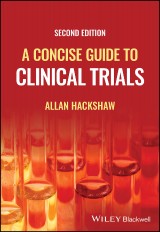Details

A Concise Guide to Clinical Trials
2. Aufl.
|
54,99 € |
|
| Verlag: | Wiley-Blackwell |
| Format: | EPUB |
| Veröffentl.: | 07.05.2024 |
| ISBN/EAN: | 9781119502760 |
| Sprache: | englisch |
| Anzahl Seiten: | 224 |
DRM-geschütztes eBook, Sie benötigen z.B. Adobe Digital Editions und eine Adobe ID zum Lesen.
Beschreibungen
<p><b>Design and execute life-saving trials with this accessible resource</b> <p>Clinical trials have revolutionized the treatment of disease and the development of life-saving pharmaceuticals. They contribute decisively to diagnosis, the avoidance of early death, medical intervention and are central to the modern work of pharmaceutical producers. The design and execution of clinical trials is one of the fastest-growing and most important areas of medical and pharmaceutical research. <p><i>A Concise Guide to Clinical Trials</i> provides an accessible and comprehensive survey of clinical trials, their design, and their applications. Beginning with a taxonomy of trial types, the book overviews stages of analysis, ethical and legal requirements, and more. Now fully updated to reflect the latest research and clinical practice, it continues to be an indispensable resource for researchers and clinicians. <p>Readers of the second edition of <i>A Concise Guide to Clinical Trials</i> will also find: <ul> <li>New material on pharmaceutical trials, adaptive designs, and the use of “big data”</li> <li>The easy-to-use organization facilitates both first-time learning and reference</li> <li>Detailed treatment of concepts such as health technology assessments (HTA), patient and public involvement and engagement (PPIE), and more</li> </ul> <p><i>A Concise Guide to Clinical Trials</i> is ideal for clinicians and healthcare professionals looking for a working knowledge of clinical trials, as well as for pharmaceutical workers and regulators looking to understand this vital aspect of the industry.
<p>Preface ix</p> <p>Foreword xi</p> <p><b>1 Fundamental concepts 1</b></p> <p>1.1 What is a clinical trial? 1</p> <p>1.2 Early trials 2</p> <p>1.3 Why clinical trials are needed 3</p> <p>1.4 Alternatives to clinical trials 3</p> <p>1.5 Types of clinical trials 5</p> <p>1.6 Key design features 7</p> <p>1.7 Summary points 13</p> <p><b>2 Types of outcome measures and understanding them 15</b></p> <p>2.1 Clinical trial outcome measures (endpoints) 15</p> <p>2.2 ‘True’ versus surrogate outcome measures 16</p> <p>2.3 Types of outcomes 18</p> <p>2.4 Counting people 18</p> <p>2.5 Taking measurements on people 19</p> <p>2.6 Time-to-event measures 21</p> <p>2.7 Patient-reported outcome measures (PROMs) 25</p> <p>2.8 Summary points 27</p> <p><b>3 Phase I trials 29</b></p> <p>3.1 Trial objectives 29</p> <p>3.2 Types of participants 30</p> <p>3.3 Outcome measures 30</p> <p>3.4 Designs 32</p> <p>3.5 Conducting the trial 37</p> <p>3.6 Statistical analysis and reporting the trial results 37</p> <p>3.7 Summary points 39</p> <p><b>4 Phase II trials 41</b></p> <p>4.1 Trial objectives 41</p> <p>4.2 Designs 41</p> <p>4.3 Outcome measures 48</p> <p>4.4 Estimating study size 48</p> <p>4.5 Stopping early for toxicity 50</p> <p>4.6 Statistical analyses 51</p> <p>4.7 Interpreting phase II studies 55</p> <p>4.8 Summary points 56</p> <p><b>5 Phase III trials: design 59</b></p> <p>5.1 Trial objectives 59</p> <p>5.2 Designs 59</p> <p>5.3 Inclusion and exclusion criteria 62</p> <p>5.4 Experimental/investigational treatment group 64</p> <p>5.5 Control (comparator) group 64</p> <p>5.6 Randomisation and allocating participants 65</p> <p>5.7 Blinding (placebo) 66</p> <p>5.8 Outcome measures 66</p> <p>5.9 Participant follow-up 68</p> <p>5.10 Estimating study size 69</p> <p>5.11 Non-inferiority and equivalence 72</p> <p>5.12 Multiplicity: multiple treatment arms or multiple outcome measures 74</p> <p>5.13 Participants who switch trial interventions (crossover) 75</p> <p>5.14 Summary points 76</p> <p><b>6 Phase III trials – fundamental aspects of analysis and interpretation 79</b></p> <p>6.1 Efficacy 79</p> <p>6.2 Safety toxicity and adverse events 96</p> <p>6.3 Adherence (compliance) 98</p> <p>6.4 Health‐related quality of life (QoL) 99</p> <p>6.5 Intention‐to‐treat and per‐protocol analyses 102</p> <p>6.6 Summary points 103</p> <p><b>7 Randomised trials – additional aspects of analysis and interpretation 107</b></p> <p>7.1 Non-inferiority and equivalence trials 107</p> <p>7.2 Composite outcome measures 110</p> <p>7.3 Subgroup (subset) analyses 111</p> <p>7.4 Crossover trials 115</p> <p>7.5 Factorial trials 115</p> <p>7.6 Cluster randomised trial 117</p> <p>7.7 Repeated measures 117</p> <p>7.8 Multiple endpoints 117</p> <p>7.9 Dealing with missing outcome data 119</p> <p>7.10 Translational research 120</p> <p><b>8 Commercial trials of medicinal products; other types of interventions; health economic analysis 127</b></p> <p>8.1 Commercial trials of medicines (drugs) 127</p> <p>8.2 Other types of interventions 135</p> <p>Surgical techniques 137</p> <p>Radiotherapy and radioactive substances 139</p> <p>Behavioural/lifestyle interventions 139</p> <p>Medical devices 141</p> <p>Cell and gene therapy 142</p> <p>8.3 Health economic analyses 144</p> <p><b>9 Systematic reviews and meta-analyses; and real-world evidence 147</b></p> <p>9.1 Systematic reviews of randomised controlled trials (direct comparisons) 147</p> <p>9.2 Meta-analyses based on indirect comparisons 154</p> <p>9.3 Real-world evidence and real-world data 159</p> <p>9.4 Summary points 166</p> <p><b>10 Conducting and reporting trials 169</b></p> <p>10.1 Working group and key roles 169</p> <p>10.2 Estimate and secure funding 170</p> <p>10.3 Patient and Public Involvement and Engagement (PPIE) 171</p> <p>10.4 Essential trial documents 171</p> <p>Trial protocol 171</p> <p>Participant/Patient Information Sheet (PIS) and Consent Form 172</p> <p>Case report forms (CRFs) 175</p> <p>Electronic database (randomisation system) 176</p> <p>Standard operating procedures (SOPs) 176</p> <p>Investigator’s Brochure (IB) 177</p> <p>Trial Master File (TMF) 177</p> <p>10.5 Ethics and regulatory approvals 177</p> <p>10.6 Trial set up 179</p> <p>Register the trial 179</p> <p>Contracts and agreements 179</p> <p>Assess site feasibility 181</p> <p>Site initiation and activation 181</p> <p>Handling and distribution of trial drugs 181</p> <p>Handling and shipping of biospecimens or imaging scans 182</p> <p>10.7 Conducting the trial 182</p> <p>10.8 Monitoring the trial and suspension/early stopping 184</p> <p>Safety monitoring and reporting 185</p> <p>10.9 End of trial 188</p> <p>10.10 Reporting and publishing trials 190</p> <p>10.11 Regulations and guidance associated with conducting trials 191</p> <p>10.12 Why trials ‘fail’ 194</p> <p>Clinical trial critical appraisal checklist 199</p> <p>Glossary of abbreviations used in clinical trials 201</p> <p>Further reading 205</p> <p>Index 207</p>
<p><b>Allan Hackshaw</b> is Professor of Epidemiology and Medical Statistics and Deputy Director, CRUK Cancer Trials Centre, University College London, United Kingdom.
ERROR
Diese Produkte könnten Sie auch interessieren:

Practical Flow Cytometry in Haematology
von: Mike Leach, Mark Drummond, Allyson Doig, Pam McKay, Bob Jackson, Barbara J. Bain
Preis: 105,99 €
-
-
© 2024 media control GmbH
Alle Preise enthalten die gesetzliche Mehrwertsteuer. - AGB
- Impressum
- Datenschutzerklärung
- Kontakt
- FAQ
- Mein Konto
- Home
- Erweiterte Suche
- Widerrufsrecht
- Reader-Software
- Desktop-Ansicht
- Gutschein-Code einlösen
- English

